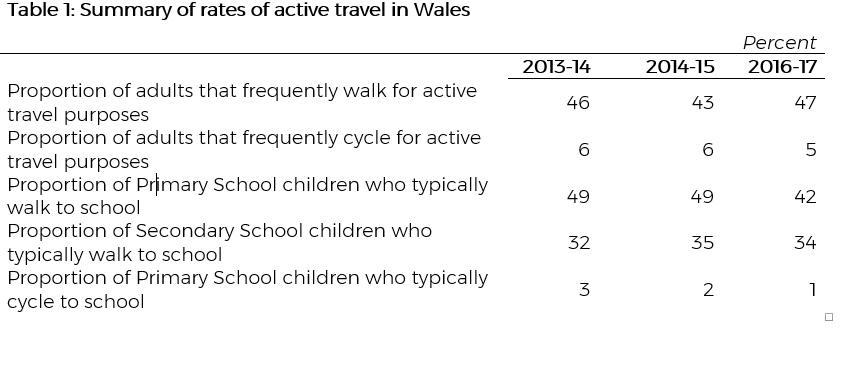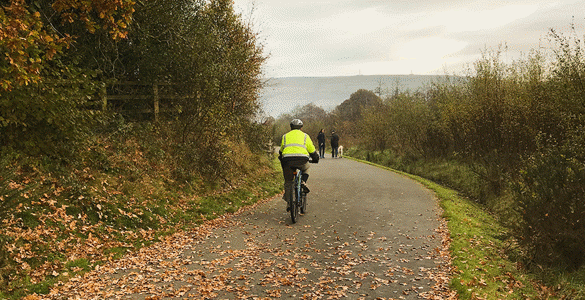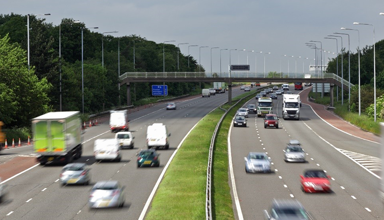While the Welsh Government’s Active Travel (Wales) Act 2013 entered into force in September 2014, Welsh Government data shows relatively little change in walking and cycling rates since then. In March the Economy, Infrastructure and Skills (EIS) Committee undertook a post legislative scrutiny inquiry on the Act identifying a range of issues, making 24 recommendations. The Welsh Government has now laid its response (PDF, 172KB) in advance of a Plenary debate on 19 September. However, some of the responses could prompt further questions.
The Act
The Act came into force in September 2014. It requires local authorities to map and continuously improve routes and facilities for “active travel” – defined as walking and cycling for a purpose, like accessing work or services, rather than for leisure.
The “Existing Routes Map” (ERM) comprises current infrastructure, while an “Integrated Network Map” (INM) should set out the infrastructure needed to create an integrated active travel network – essentially a rolling 15 year plan.
Both the Welsh Ministers and local authorities are under a duty to promote active travel. Both - in their capacity as highway authorities – are also required to consider enhancing provision for active travellers when carrying out certain functions like building or maintaining highways.
Guidance was issued to support delivery, and a non-statutory Active Travel Board and Action Plan sit alongside the Act.
Impact
The Explanatory Memorandum (PDF 474KB) which accompanied the Active Travel Bill identified benefits from increased active travel rates in terms of health, climate change, addressing poverty and supporting economic growth.
Many of these potential benefits were illustrated in Moving Forwards: Healthy Travel in Cardiff and the Vale of Glamorgan published by Cardiff and Vale University Health Board around the time the Committee was gathering evidence.
In 2013 during stage 1 scrutiny of the Active Travel Bill (PDF 517KB), the Minister responsible for its passage, Carl Sargeant, described the Act “the game-changer”.
Yet the Committee was disappointed by progress.
The Welsh Government’s most recent annual statistical bulletin on active travel in Wales (January 2018) showed little change in active travel rates since the Act was passed.  During his February 2018 statement following the submission of INMs, the Cabinet Secretary for Economy and Transport, Ken Skates, accepted concerns over these data – noting “a worrying decline in the number of young people who are walking.”
During his February 2018 statement following the submission of INMs, the Cabinet Secretary for Economy and Transport, Ken Skates, accepted concerns over these data – noting “a worrying decline in the number of young people who are walking.”
However, he also pointed to more encouraging figures for children living within a 10 minute walk from school, and suggested adults already walking and cycling were doing so more frequently. Yet he acknowledged “that those who have not been walking are still not walking” – a key target group for the Act.
Discussing active travel trends, the Committee heard evidence suggesting that the mapping process had diverted focus from infrastructure delivery and promotion of active travel. However, the Cabinet Secretary told the Committee “in terms of infrastructure…the spend has been considerable”. Nevertheless, witnesses and consultation respondents to the Committee’s inquiry called for increased funding.
Findings
The Committee’s report identified issues and made recommendations in a number of areas.
The Committee was disappointed with progress to date. It felt “more momentum” is needed to turn active travel rates around, while “strategic leadership” was felt to be lacking at Welsh Government and local government level. INMs “are yet to become an integral part of wider planning and transport policies” and mapping generally should be a less “time consuming task” to avoid diverting resources. Despite the Cabinet Secretary’s comments, the level of funding was felt to be “constraining…ambitions”, while duties to consider active travel in highway authority functions “are not being effectively applied”.
Consultation and engagement has not reached the people not currently travelling actively, and the Committee welcomed the fact that the Cabinet Secretary had rejected several INMs where consultation was inadequate.
However, limited capacity within local authorities and fears around managing public expectations in the absence of funding were also recognised as constraints. The Committee advocated co-production alongside consultation – describing both as “essential factors…when developing infrastructure that meets the needs of a diverse community.
Guidance was another key area, with leadership again highlighted along with a need to ensure guidance had appropriate status with planners and engineers. Wider issues like sharing best practice, and effectively balancing flexible interpretation with the need to ensure infrastructure meet the needs of the whole community were key. The need for engagement with professional bodies and key groups like planners and civil engineers to break down cultural barriers to implementation of guidance was identified.
In terms of non-statutory elements of active travel policy, the Active Travel Board was described as a “missed opportunity”. The Committee felt it needed an independent Chair as well as “terms of reference that give it teeth”. The Active Travel Action Plan lacks targets, deadlines and funding and “is in danger of being little more than a collection of aspirations”.
Finally, questions on approaches to behaviour change, and recognition of the complexity of the issues involved, led to a recommendation that Public Health Wales should be directed to act in this area.
Finally, almost inevitably, resources capacity and capability in delivery of the Act were flagged, including the need for “a significant increase in funding, with multi-year commitments, covering both infrastructure and behaviour change / promotion”.
Funding
Investment was a major issue in the inquiry. The Welsh Government funds local authorities to invest in active travel infrastructure through Road Safety and Safe Routes in Communities Grants and the Local Transport Fund. These grants have increasingly focused on active travel in recent years as implementation of the Act has progressed.
On 1 May, around the time the Committee’s report was published, the Cabinet Secretary for Finance announced increased funding for active travel in his Plenary statement on the Wales Infrastructure Investment Plan Mid-point review. From a total “new capital funding package of £266 million”, he announced:
£60 million over three years to accelerate the creation of active travel routes to connect residential areas, work, education sites and services.
Approximately £10m was allocated in the current year, with £20m profiled for 2019-20 and £30m in 2019-20. Together with wider funding streams, the Welsh Government has estimated total spend to be nearly £92m – or approximately £10 per head. This represents progress, albeit still some way short of the £17-20 per head recommended by the Committee.
Analysing the Welsh Government Response
The Welsh Government accepted eleven recommendations, with a further eleven accepted “in principle”, and two rejected.
Many of the commitments made in the response will be welcomed. For example, in accepting recommendation 6, on addressing cultural and other barriers to the use of guidance, the Welsh Government commits to work with professional bodies including on Continuing Professional Development.
Equally, inconsistencies in audit tools included in design guidance will be addressed (recommendation 9), and commitments are made to update design and grant application guidance to clarify how deviations from standards should be applied where they are needed (recommendation 11).
Increased funding will also be welcomed.
However, a look at other aspects of the response might prompt a few questions, which can be illustrated by a couple of examples.
The Government accepted recommendation 12 “in principle” which proposed that the Board should have an independent Chair, terms of reference which “give it teeth”, be responsible for monitoring the Action Plan and create targets for delivery with the Cabinet Secretary.
It rejected recommendation 13 – that Active Travel Board membership should be reviewed and should exclude Welsh Government officials.
In both cases the response indicates that the Board itself considered these recommendations. This is interesting not least because bodies which are members of the Active Travel Board were among those raising issues with its governance, membership as well as the importance of Action Plan targets etc. in evidence to the Committee. While there may be differing opinions on the detail of the recommendation, some appetite to review the Board’s operations might have been expected.
It’s also interesting to note that the text response to recommendation 12 only addresses membership and Chairing arrangements and makes no comment on strengthening terms of reference, supervision of the Action Plan or target setting etc which were also included in the recommendation.
In responding to recommendation 1 – which focused on the need for “strengthened” Welsh Government leadership and which was also accepted “in principle” – the Welsh Government said that it:
…has already shown leadership in the implementation of the Active Travel Act….[and]…the Welsh Government has published guidance for all local authorities to support them in their statutory duties and provides significant funding for authorities.
Yet the Committee will presumably have considered the level of leadership “already shown”, as well as historic funding levels and approach taken in guidance in concluding stronger leadership is needed. The impact and meaning of accepting “in principle” in these circumstances could be considered unclear.
With the mapping process now complete, funding increased and clear commitments from the Welsh Government to the goal of increasing active travel rates, there will no doubt be high expectations for this policy area.
Yet the ultimate test will not be the response to this report. Rather it will be future data on active travel rates in Wales.
Many inside and outside the Assembly will wait with interest to see whether the promise of this Act will be fulfilled.
Article by Andrew Minnis, National Assembly for Wales Research Service
Table source: Welsh Government






